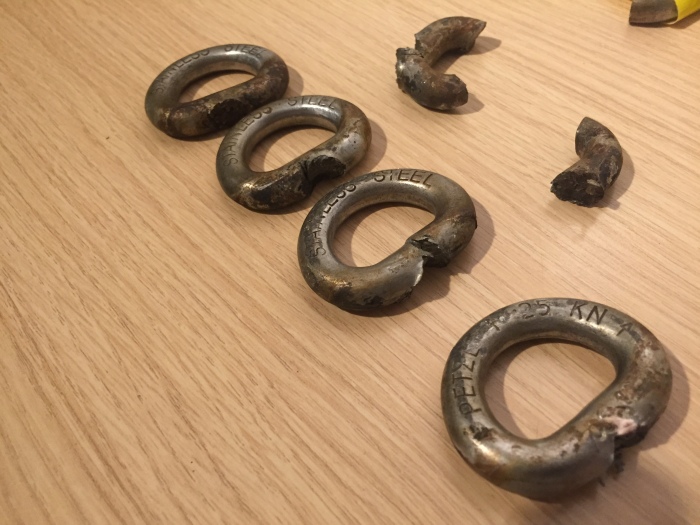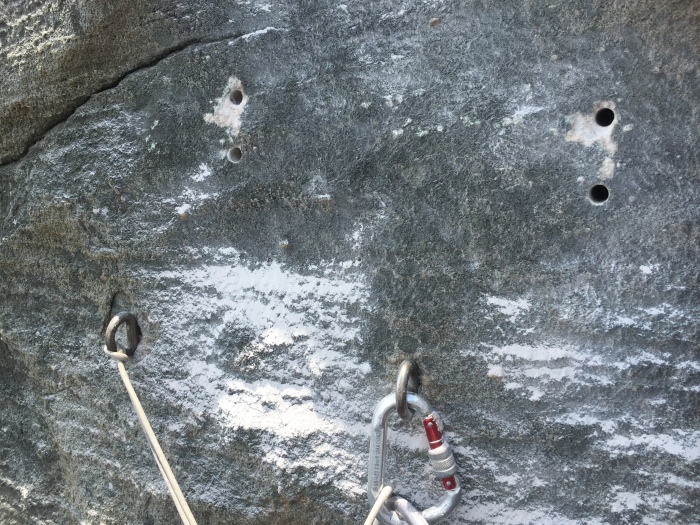
If you have been following me on Facebook, you would have known I with the help of local champ Xiao Xiang have started to rebolt some anchors in Long Dong, Taiwan with Titan’s titanium U bolts. The reason for doing this is simple, UIAA have issued a warning on using stainless steel bolts on sea side crags and recommends sea side crags susceptible to SCC (Stress Corrosion Cracking) to use only Titanium bolts.
UIAA Warning about climbing anchor failure

What does this mean? Does it mean that all stainless steel bolts are going to fall from the sky? Is it still safe to climb in Long Dong, Taiwan?
This is a 304 anchor bolt removed from The Wedding Route (mega popular 5.7 classic) at Music Hall sector in Taiwan, Long Dong. The bolt sample has been sent to UIAA for analysis.
This simply means that all bolts in sea side cliffs that have cases of SCC eventually needs to be replace with Titanium bolts. SCC takes time and in different stages, it can either show no signs of corrosion or simply just break at its final stages. This means that there is no way to see or test if the bolt is safe to use. We can however make a ‘safe’ assumption that the higher grade stainless steel bolts widely used in Long Dong 316 stainless steel, will still have some ‘time’ left until the final stages ‘arrive’.


Does this means it is safe? No, it just means that we have to start replacement of all bolts starting from the ones that have history of failure (304 stainless steel and expansion bolts). Rebolting is a long process, using loads of manpower, time, money, sweat and of course politics. However it has to be done in order to maintain a ‘safe’ status of bolts in a climbing area. Eventually, all bolts will be replaced with Titanium bolts however we have be critical now and replace anchors that are in the danger of failing like the July 2015 Big Drum incident.


Luckily, we have some help from the local outdoor company, Outdoor Adventure International Inc, 探索戶外國際股份有限公司. They put us in the right position by giving the taiwan rock climbing community 350 Titan Titanium U bolts! Kudos to Liu Kuan Chieh who is a major support of our push for replacing dangerous anchors in Long Dong.


In the rebolting process, we have decided to use U bolts because of the ease of rappelling from these anchors with out additional links or carabiners attached to the bolts. Without the proper usage of these new U bolts, they will eventually wear out and require another rebolting process. The answer to this issue is to use the correct technique to get off various type of anchors.

Anchors with replaceable links like some sports routes in Long Dong, anchor rings in Krabi and quick links with chains in Singapore and Malaysia are relatively acceptable to lower off them and clean the routes. However I would still recommend all climbers to rappel off fixed hardware on the walls. The simple reason being, it takes time and effort to replace these hardwares and since its public hardware, we should take care of it and reduce wear and tear on them. Worn out anchors can fail (obviously) and also cut your rope!

http://www.rockandice.com/lates-news/climb-safe-dangers-of-rope-worn-carabiners )
With this in mind, bolts are permanent installation in the rock and there is no way to replace them ‘cleanly’ unless you drill another hole. We certainly do not want to have a anchor station with 10 different generation of bolts. And hence we are recommending all climbers to clean routes on rappel as shown in the video below when you encounter anchors with just 2 bolts.

Do consider this the next time you get off a route and take care of fixed climbing hardware in climbing areas because the next person using it might have it fail on them because it is too worn out!
The video of cleaning on abseil was a good reminder and refresher for me. Thanks! Serena
Looking forward to have you back in Taiwan soon to do some climbing soon!